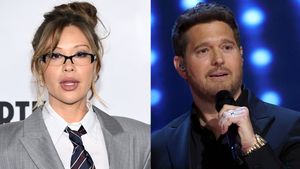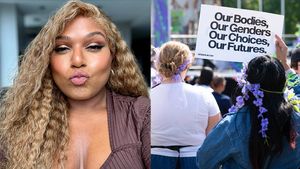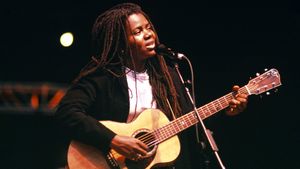"Is that
all there is?" sang Peggy Lee.
I can't
honestly say those were the first words that wafted through
my head when I read the shocking plurality opinion of
New York's high court last week, refusing to
strike down the exclusion of same-sex couples from
marriage. The first words were more like "twisted
legal reasoning" (New York Times
editorial, July 7), "callous and insulting"
(Matt Foreman, National Gay and Lesbian Task Force),
or "outdated and bigoted" (Howard Dean,
Democratic Party).
Just five weeks
after oral arguments in the freedom-to-marry cases
brought by 44 couples and their children, the New York court
of appeals (the state's highest court) ruled,
4-2, that it is not necessarily
"irrational" for the law to exclude same-sex
couples and their loved ones from marriage. Applying a
toothlessly minimal scrutiny to the denial of
something as important as the freedom to marry, the
plurality held that the limitation of marriage to
different-sex couples could be arguably justified on
the basis of either of two possible rationales. First,
heterosexuals, who can conceive children by accident, need
the stability that marriage brings (whereas gay
couples, whether or not raising children, do not).
Second, the denial of marriage, in the court's words,
could relate to the "intuition" that a
"child benefits from having before his or her
eyes, every day, living models of what both a man and a
woman are like," even though, the judges
conceded, there is no actual evidence that this is so
or that children raised in other homes, including by gay
parents, are at all harmed.
Put aside for the
moment, as the dissent explained, that "marriage is
about much more than producing children, yet same-sex
couples are excluded from the entire spectrum of
protections that come with civil
marriage---purportedly to encourage other people to
procreate." In fact, the plurality's
strained rationalizing of the discriminatory exclusion
fails on its own terms.
New York's
ruling came just a week after the Arkansas supreme court
unanimously rejected precisely the same proffered rationale;
unlike the four-member majority of New York's
highest court, the judges in Arkansas (!) instead
relied on the evidence provided by experts in child welfare.
That evidence was, of course, available to the New York
judges. Institutions such as the American
Psychological Association, the National Association of
Social Workers, the American Psychiatric Association, the
Association to Benefit Children, and the American Academy of
Matrimonial Lawyers, among other authorities,
submitted briefs to the court calling for an end to
marriage discrimination in the interest of children and
families.
And the very week
of the New York decision, the American Academy of
Pediatrics weighed in once again with an authoritative
statement titled "The Effects of Marriage,
Civil Union, and Domestic Partnership Laws on the
Health and Well-being of Children" (see the
academy's full analysis on
www.freedomtomarry.org). The nation's kids'
doctors know best--and here's what they
said:
"There is
ample evidence to show that children raised by same-gender
parents fare as well as those raised by heterosexual
parents. More than 25 years of research have
documented that there is no relationship between
parents' sexual orientation and any measure of a
child's emotional, psychosocial, and behavioral
adjustment. These data have demonstrated no risk to
children as a result of growing up in a family with
one or more gay parents. Conscientious and nurturing adults,
whether they are men or women, heterosexual or
homosexual, can be excellent parents. The rights,
benefits, and protections of civil marriage can
further strengthen these families."
Not only was this
evidence, this kind of careful consideration of what
truly helps couples and kids missing from the New York
plurality opinion, so was any actual logical
connection between the ends ostensibly sought
(promoting stability, helping children) and the means chosen
(denying that stability and help to others). As Chief
Judge Judith Kaye explained in her powerful and
persuasive dissent (required reading for all Americans
who want to understand why our nation needs marriage
equality: www.freedomtomarry.org), "it is not
enough that the State have a legitimate interest in
recognizing or supporting opposite-sex marriages. The
relevant question here is whether there exists a rational
basis for excluding same-sex couples from marriage,
and, in fact, whether the State's interests in
recognizing or supporting opposite-sex marriages are
rationally furthered by the exclusion."
Under proper
equal protection analysis, neither the "accidental
procreation" rationale for heterosexual
"stability through marriage" nor the
"best interests of the children" rationale for
favoring one kind of family holds up as a
justification for the denial of gay people's freedom
to marry.
As the dissent
pointed out, "Defendants primarily assert an interest
in encouraging procreation within marriage. But while
encouraging opposite-sex couples to marry before they
have children is certainly a legitimate interest of
the State, the exclusion of gay men and lesbians from
marriage in no way furthers this interest. There are enough
marriage licenses to go around for everyone....
[After all,] no one rationally decides to have
children because gays and lesbians are excluded from
marriage."
The
plurality's failure to even consider the lived
realities of the 44 plaintiff couples, their kids, and
the hundreds of thousands of gay New Yorkers and their
families injured by the denial of marriage undoubtedly
contributed to the retrograde and astonishing suggestion
that the different-sex restriction on marriage somehow
helps kids. In fact, as Judge Kaye noted, "the
exclusion of same-sex couples from the legal
protections incident to marriage exposes their children to
the precise risks that the State argues the marriage
laws are designed to secure against." That
would be so even if the "intuition" that there
is one "best kind of family" were
true---irrelevant as that is to kids who, after
all, have the families they have, and don't deserve
the laws making their family's life any harder.
So why did Peggy
Lee come to mind today? I got an e-mail from a friend
this morning. She asked me if, 10 years after winning the
marriage trial in Hawaii, which turned on the
state's failure to show that excluding gay
couples from marriage in any way helped children, I could
believe that we were hearing such illogic, such
obliviousness to the needs of same-sex couples and
their kids, such insufficient justifications for denying
something so important as marriage yet again--and in
New York, no less.
Is that all there is? I thought. All they've
been able to come up with since we refuted these same
unsubstantiated and unconnected assertions a decade
ago? In fact, this is all they've got to justify
dragging out the pointless exclusion of gay couples from
marriage. I believe we need to take people's
concerns and questions seriously; that's why I
wrote my book, Why Marriage Matters. When people
start to think it through, pushing past their
discomfort, all the opponents of equality have left is
a strained and unconvincing set of
assumptions--intuitions---that can only be
thought to pass muster on the most minimal level of
constitutional scrutiny. The perpetuation of
discrimination rests on habit, inertia, fear, and
conjectural rationales belied by evidence and logical
connection. If we do our job of giving people the
information enough times over enough time, all they will
have left is, as Lincoln put it, "as thin as
the homeopathic soup made by boiling the shadow of a
pigeon that had starved to death."
The silver lining
of the decision is, ironically, its thinness, illogic,
and refusal to consider the lives of real people, including
gay families, and the real meaning of the denial of
the human experience that is marriage. While the
dissent makes a convincing legal and moral case, the
plurality and concurring opinions will present no impediment
to a court or decision-maker wanting to do what is
right and willing to apply real scrutiny to a
constitutional and moral wrong. As the Human Rights
Campaign's Joe Solmonese put it, "If nothing
else, this ruling will cause people---gay and
straight alike---to reflect on this judge's
unusual view of gay marriage and then come to their
own conclusions."
And, because, in
the words of The New York Times, "New
York's highest court has harmed both the
constitutional guarantee of equal protection and its
reputation as a guardian of individual liberties by
denying same-sex couples the right to marry," not
just gay people, but also nongay, as people who care
about fairness and equal protection under the law, are
rightly feeling dissed and pissed. The Times editorial
concluded, "Those who favor gay marriage need to
quickly move past this week's disappointment
and get energized. That also applies to those in the
other states where courts have failed to uphold the rights
of all Americans."
So what next?
In one of his
characteristically eloquent and heartfelt pieces, Andrew
Sullivan got it mostly right. Sullivan unduly disparages the
important and legitimate role of the courts (those of
us who respect America's precious system of
constitutional guarantees and checks and balances,
unlike right-wingers who criticize judges for doing their
job, criticize judges only for not doing their job).
But his bottom-line is right-on: "We have the
better arguments. Let's make them to the people and
their elected representatives, and we'll win in
the end."
In New York now,
this means the fight redoubles and shifts to the court
of public opinion and the legislature, as a broad nongay and
gay coalition spearheaded by the Empire State Pride
Agenda and other groups, holds public officials such
as likely next governor Eliot Spitzer, New York City
mayor Michael Bloomberg, the assembly speaker, and the
senate majority leader to their obligation to end this
pointless discrimination. In other states we rightly
and strategically press forward both in the courts and
the legislatures, looking to historic achievements such as
California's passage of a marriage bill in 2005 and
Massachusetts's repudiation of an antigay
attack, both vindicated at the polls when not a single
pro-marriage elected official was defeated because of his or
her vote. And, meanwhile, in all states we make the
case for fairness and equality and why marriage
matters around kitchen tables, in the workplace, in
places of worship, and in our speaking out, person to
person, group to group.
And as we make
the case, breaking the inertia that allowed this court to
stumble, we take heart that more and more nongay people now
are joining us in speaking out. They are making their
voices heard in the courts, as in the breadth of
friend-of-the court groups assembled by Lambda Legal,
the American Civil Liberties Union, the National Center for
Lesbian Rights, Gay and Lesbian Advocates and
Defenders, and the law firms at their sides. They are
making their voices heard in the court of public
opinion, as witness the American Academy of Pediatrics and
the pledges of candidates such as the Democrats
running for governor in both California and New York.
And they are making their voices heard from the courts,
making the case as commonsense and inescapable as these
words from Chief Judge Kaye:
"The true nature
and extent of the discrimination suffered by gays and
lesbians...is perhaps best illustrated by the simple
truth that each one of the plaintiffs here could
lawfully enter into a marriage of convenience with a
complete stranger of the opposite sex tomorrow, and
thereby immediately obtain all of the myriad benefits and
protections incident to marriage. Plaintiffs are,
however, denied these rights because they each desire
instead to marry the person they love and with whom
they have created their family."
In the course of
the New York litigation, the discussion around who gay
families are, what equality means, and why marriage matters
pushed public opinion from 47% in favor of ending
marriage discrimination to 53%. Against the power of
our truth and the inevitable rise to ascendancy of
younger people who favor the freedom to marry, opponents of
equality have only increasingly hollow appeals to
"intuitions" and "traditions"
that merely perpetuate rather than justify
discrimination, present but curable discomfort that
manifests itself in illogic and---here's where
the ball is in our court---inertia that results
from the failure of those who care to speak up and
take action.
"Is that
all there is? If that's all there is, my friends,
then let's keep dancing," sang Peggy
Lee. If dancing means engaging others, by all means
let's dance; this discordant, tinny ruling did not
stop the music. And if dancing means, well, dancing,
then let's keep working until all committed
couples can dance, with family, friends, and loved ones, at
their weddings, pursuing happiness, celebrating their
commitment and love, equally protected by the law and
the respect due every person.


















































































